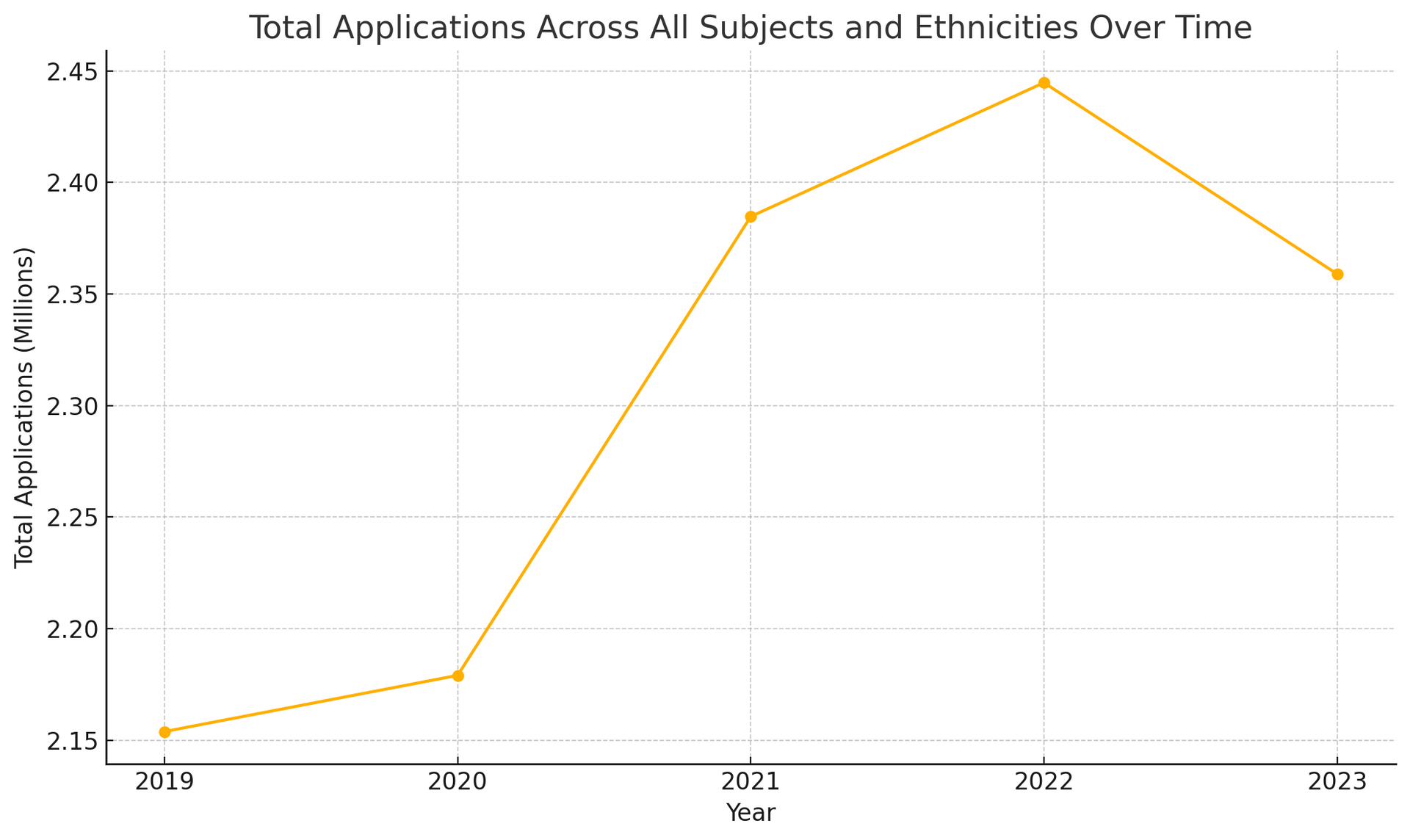Degree By Numbers
How is the landscape shifting?

With schools now returned, many 6th formers will be applying to university in the next few weeks. In this article we look at past trends in subject application to identify which subjects have increased in popularity and which have decreased. In particular, we look at trends by ethnicity to see whether there are differences between ethnic groups.
Data are taken from UCAS and cover the period 2019 to 2023. Complete cycle data for 2024 is not yet available .
Overall applications
Applications to university have increased markedly in the last few years despite a drop in applications last year. Applications peaked in 2022 but fell back in 2023.
Provisional figures suggest that the number of applicants for 2024 will also be down slightly from 2023.

Much of the decrease in applications is driven by a fall off in applications from White students. These fell by over 114,000 from 2022 to 2023 but were still well above the 2019 total.
Conversely, applications from every other group climbed over the whole period including 2022 to 2023 although increases have been gentle. It seems that initiatives aimed at increasing access from disadvantaged communities have helped along with the more general appeal of university among black and minority ethnic groups.

What subjects have become more popular and which ones less popular?
By plotting the percentage change in each subject since 2019 (normalised to take into account variations in the number of applicants), we can identify variations by subjects.
The most notable increases are in computing, medicine and dentistry, and law, with computing showing a particularly sharp rise of nearly 20%. This suggests a growing interest in fields related to technology and healthcare, likely driven by the increasing digitisation of society and the ongoing importance of healthcare professions.
On the other hand, subjects like language and area studies, education and teaching, and physical sciences have seen significant declines in applications, with language and area studies experiencing the steepest drop. This decline might indicate shifting student priorities away from humanities and traditional science fields toward more career-oriented or technology-focused disciplines.

In relation to ethnicity, one of the most striking observations is the variation in subject preferences among different ethnic groups.
The Black ethnic group shows a notable increase in applications for language and area studies, social sciences, and combined and general studies. However, they experienced a substantial decline in computing and architecture, building, and planning, indicating a shift away from STEM and technical subjects towards humanities and interdisciplinary studies.
The Asian ethnic group shows significant increases in language and area studies, biological and sport sciences, and geography, earth, and environmental studies.
For the Mixed ethnic group, computing stands out with the most significant positive change. Education and teaching, language and area studies, and physical sciences also saw substantial growth among this group. The trend for Mixed applicants suggests a balanced interest in both traditional sciences and humanities.
The White group, interestingly, has a much flatter distribution of changes, with education and teaching showing the most significant positive change. Subjects allied to medicine, design and creative arts, and physical sciences also saw moderate increases.
The relationship between earnings and applications
With tuition fees, student loans and high interests rates making the financial advantage of a degree much less clear, potential students might decide to apply to subjects that lead to higher paid jobs. Subjects such as medicine, subjects allied to health, some elements of engineering and technology and veterinary services have traditionally been the best payers for graduates. How much has this influenced applications over the last five years?
The chart plots annual changes in the percentage of applications to highest earning subjects, normalised to take into account the variation in the number of applications each year.

The chart reveals that while the absolute number of applications to higher earning subjects (such as medicine, engineering, and veterinary sciences) has generally increased over time for Black, Asian, Mixed, and Other ethnic groups, the proportion of these applications relative to the total applications has shown a downward trend from 2021 onwards. This suggests that although more students from these ethnic groups are applying to these high-earning fields, the growth in applications to other subject areas is outpacing the growth in higher earning subjects.
For the White ethnic group, the chart shows a significant decline in the proportion of applications to higher earning subjects starting from 2021, which is further compounded by a decline in the absolute number of applications since 2022. This suggests that students from the White ethnic group are not only applying less frequently to these high-earning fields in relative terms but are also reducing their overall applications to these subjects. This could indicate a broader shift in academic interests, with fewer students pursuing traditionally high-earning subjects, potentially reflecting changing career aspirations or a growing interest in alternative fields that are perceived as more aligned with personal values or emerging job market trends.
Several factors could be contributing to this trend. One possibility is that there is a broader diversification of subject interests within these ethnic groups, with increasing numbers of students exploring fields outside of the traditionally high-earning disciplines. Another potential factor could be that while the overall volume of university applications is rising, the rate of increase in applications to higher earning subjects is not keeping pace, leading to a relative decline in their share of total applications. This dynamic indicates a shift in academic preferences and potentially in career aspirations, as students might be seeking opportunities in a wider array of fields.
Conclusion
The variations in subject preferences among different ethnic groups highlight the diverse factors influencing student choices, including cultural values, perceived job market opportunities, and possibly targeted outreach or support programs. Universities and policymakers may need to consider these differences when designing initiatives to promote inclusivity and diversity in higher education, ensuring that all groups have equitable access to a wide range of academic and career paths.









